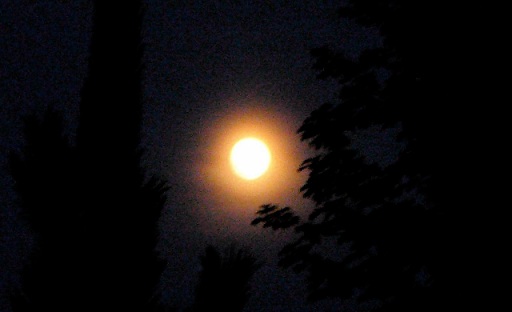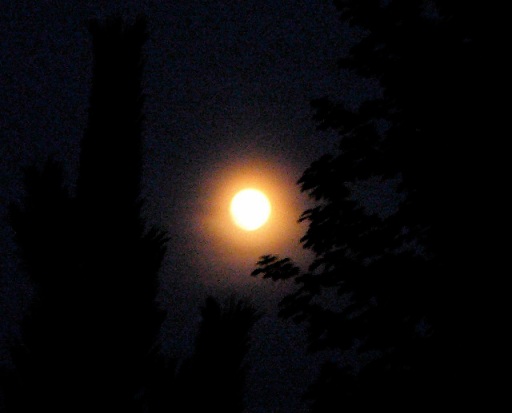Full Moon Almanac
Wolf Moon
lights snow-blue fields
embossed with paw print trails
to where January ghosts howl
Ice Moon
Snow Moon
February’s
bluster winds heap white dunes
We’ve stocked the cupboard full against
Storm Moon
Worm Moon
March’s wiggly
trails of melt, then Crust Moon
Spring so white and pure we call her
Chaste Moon
Pink Moon
wild flowers bloom
as April birds return
to build twig nest, lay a sky blue
Egg Moon
Flower
Moon of May
Bunnies hop in Hare Moon
Farmers dream Planting Corn Moon and
Milk Moon
Rose Moon
Strawberry Moon
of June when hard green fruits
soften, blush under sun’s rays, night’s
Hot Moon
Buck Moon
July’s the time
to hunt, replenish stores
then sleep secure through Thunder Moon
Hay Moon
Red Moon
August’s smoky
skies color Sturgeon Moon
while green Corn Moon sprouts, promises
Grain Moon
Harvest
Moon, September
lights nights of bringing in
oats and wheat under Barley Moon
Corn Moon
Hunter’s
Moon, roam under
October’s Travelers
Moon, stalk prey in frosty Dying
Grass Moon
Beaver
Moon, the busy
rodents mend their dams in
icy blue November’s grip of
Frost Moon
Cold Moon
lights Christmas paths
December’s carollers
so bright you could forget it’s Long
Night Moon
Blue Moon
rare-month moon
when full moons multiply
their charm, mystery, magnetism
My Moon
– Violet Nesdoly
***************
The November 2nd Poem-A-Day prompt was to write a full moon poem. I know there’s a lot of interesting lore about moons—full moons in particular. So I went hunting for some before I wrote my poem. My favorite find was a wonderful National Geographic article called “Full Moon: What’s in a Name?” It listed names the full moon has been called in lore and history through the months of the year, and gave the genesis of many of these names.
I wrote the poem in cinquain form (a 2-4-6-8-2 syllable cinquain) to keep myself reined in and the poem compact—seeing as how it would go on for 13 stanzas in any case.
 This poem is submitted to Poetry Friday, hosted today by kidlit maven Anastasia Suen at Book Talking.
This poem is submitted to Poetry Friday, hosted today by kidlit maven Anastasia Suen at Book Talking.



I love this, Violet! Very serene, yet there’s quite a bit of action going on, with the harvest and rats mending dams. I think the conquain form works well, too…and I think you covered just about every moon there is, except for the one over Miami! 😉
LikeLike
I’ve studied some of those moons with my students, Violet. I wish I’d had your poem to use in that study! What a wonderful combination of the names you’ve woven. I especially like the Red Moon stanza, those skies coloring the sturgeon moon. Lovely.
LikeLike
Thanks Linda. That National Geographic article was wonderful find for information. I learned so much myself!
LikeLike
Violet – great poem! Great minds think alike, check my poem, ‘Shine On’ out that I posted on Monday!
http://www.mattgoodfellow.blogspot.co.uk/2012/11/shine-on.html
LikeLike
You’re right–we’re on the same page. I love your version, so compact, and rhyming too. (I also enjoyed your wolf poem from this week. Shivers…)
LikeLike
Hi, Violet. Lists of names like your moons — words for groups of animals, adjectives for different leaf shapes — fascinate me. This poem looks as if it was fun to write. My favorite here was the egg moon:
wild flowers bloom
as April birds return
to build twig nest, lay a sky blue
Egg Moon
LikeLike
Thank you, Laura. You’re right, it was fun. My goal was to include as many names as I could and still make sense, while fitting it into the cinquain form. There were few head-scratchy moments for sure, but a sense of accomplishment when it was completed.
LikeLike
I’ve always loved the different moon names and you did such a great job of describing them. Delightful- pure and powerful!
LikeLike
Thank you, Iza!
LikeLike
Wow, what a tour de force! I absolutely love this concept, Violet, and how you wove a year of moons for us. My favorite is the same as Laura’s — the birds who return to “lay a sky blue Egg Moon” – beautiful! Now you’ve given me some-much needed writing inspiration …. off to find a suitable subject! Thank you!
LikeLike
You’re so welcome! Make sure to let us know when you’ve composed your piece, Renee. (Maybe you’ll read it for us some PF?)
LikeLike
I love ho you ended with a blue moon! 🙂
LikeLike
Thanks Anastasia (and also for hosting this week’s Poetry Friday!).
LikeLike
This is wonderful, Violet. Such a great idea to celebrate all the different moons — Love that you ended with blue moon, too, “your” moon. I’m voting for the “sky blue egg moon” as my favorite too :).
LikeLike
Thanks Jama. Now if I’d been on my toes, I’d have fit in a cheese moon somewhere for your benefit. (Love the peanut butter series on your blog!)
LikeLike
I have a friend who sends out a full moon alert every month. I’ll send him a link to this poem. I love that you combined research and form with your poetry exercise, a great model for student writers.
LikeLike
Thanks Margaret! A full moon alert… how clever is that! About the research and form, those are two things that can make poetry a lot of fun. (Or maybe it’s the teacher in me that always likes to learn something, no matter what I’m doing!)
LikeLike
Really lovely Violet. My fourth grader is studying the moon at school, and we’ve enjoyed these names too. Still mastering phases, apogee, perigee. All great words!
LikeLike
Thanks Cathy! There’s always so much more to learn, isn’t there?
LikeLike
Names of the Moon
[A Found Poem]
English Colonial
Celtic Medieval Chinese Sioux American
January Quite Wolf Holiday Wolves Run Together Winter
February Ice Storm Budding Dark Red Calves Trapper’s
March Wind Chaste Sleepy Sore Eye Fish
April Growing Seed Peony Greening Grass Planter’s
May Bright Hare Dragon Ponies Shed Hair Milk
June Horses Dyad Lotus Making Fat Rose
July Claiming Mead Hungry Ghost Ripe Wild Cherries Summer
August Dispute Corn Harvest Geese Shed Feathers Dog’s Day
September Singing Barley Chrysanthemum Scarlet Plum Harvest
October Harvest Blood Kindly Changing Season Hunter’s
November Dark Snow White Falling Leaves Beaver
December Cold Oak Bitter Deer Shed Their Horns Christmas
LikeLike
I’m sorry that poem did not format properly.
LikeLike
Thank you Patrick! What a find!! Actually I like the way it formats, with the months of the year down the left margin. But maybe you had something more in mind.
LikeLike
How wonderful! I had no idea all these names existed. Off to read the National Geographic article.
LikeLike